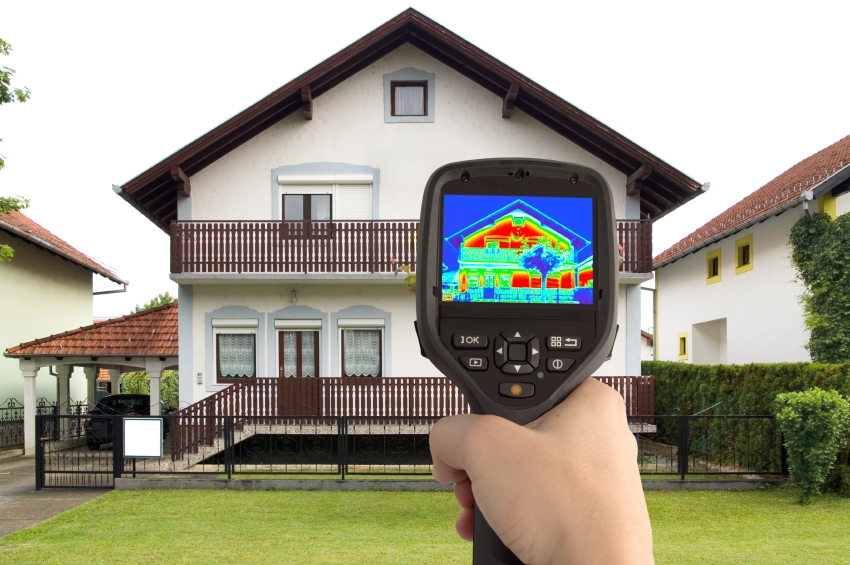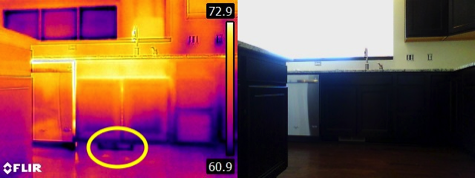
Real estate is expensive and one of the services many future homeowners will pay for is a home inspection. Though a home inspection is not required to obtain a mortgage or close on a house, it is a good idea and highly recommended. A home inspection report provides information about what is/is not working in the home or needs replacing. Many home inspectors use thermal imaging when conducting their inspection. Did you know that not all inspection companies use thermal imaging for their inspections? Let’s take a look at why hiring a home inspector who uses thermal imaging can help you in your next home purchase:
FLIR Infrared Camera
This is the use of FLIR (Forward Looking Infrared) infrared cameras (IR) or videos to check the inside or outside temperature of a building. Depending on the color of the scan, it designates whether there are hot or cool areas (too much heat or air escaping), water leaks, moisture intrusion, electrical that is malfunctioning, leaks in the ductwork and more. These are things that not seen with the naked eye.
Internal or External Inspection? That is the Question…
The home inspector decides if an inside or outside inspection will be best. Elements such as wind and outside temperature can make an internal scan the better choice. The internal scan also is more likely to catch the flow of the air because of how it radiates off an object. In addition, heat and air don’t escape straight out of a home and often go through an inside wall and this might not be picked up from the outside. In southern climates like Florida, the inspector may have the air conditioner on and go through the house with the scanner to see where the air is escaping. Typically, in Florida, an internal inspection is best practice due to the extreme heat/sun.
Thermal Imaging With the Infrared Camera
The infrared camera shows colors such as white, red, yellow, and light colors for warmer to hot areas. The blue to black and darker areas are cooler. The colors represent temperature differentials. Look at the example below, this could be showing a lot of air loss in the attic areas and windows in the front right side. The inspector will have an idea from the outside what might be going on indoors and further inspection is needed.

Thermal Imaging Shows Water Leaks and Moisture Intrusion
Do you have a water stain on the ceiling? The naked eye may be able to see the water stain but the IR camera can give the technician insight into what is going on. The evening is the best time to use the IR camera to look for a leak or moisture intrusion in the ceiling because the area has cooled off from the day temperatures. Moreover, evaporating water will show cooler temperatures rather than normal surface temperatures. If it shows up as blue or purple, there may be a leak. If the lights are orange or red, it may be okay and further inspection is suggested.
One of the great things about the IR camera is that it can allow the inspector to zero into questionable areas. This is a great idea as it can be done without intruding on the homeowner’s daily activities or tearing apart areas that are not needed to be touched.
Here is a great video about how a home inspector uses an IR camera to find moisture leaks and eventually mold in the home using an IR camera.
Electrical Issues
Sometimes we cannot see the electrical issues in the home. We don’t have a way to know if the breaker panel is functioning as it should, or if it is hanging on for dear life! The IR camera the home inspector uses can pick up these issues. Focusing the IR camera on the electrical box will tell us the temperatures. Also, putting the camera in front of an electrical appliance like this one in a kitchen in a new home (shown below) will show that it is not working correctly. The blue color is the indicator.

Thermal Imaging Can Find Insulation Problems
In order to keep heating and air conditioning bills low, proper insulation throughout the entire home is important. One little area of insulation missing can cost us extra money on our bill each month. Inspectors can look for temperature differentials or color differentials with an IR camera to see if insulation is missing. Having this information, the inspector can recommend adding insulation in targeted areas.
Ductwork Leaks
Ductwork can leak when air moves from the A/C or furnace to a particular room destination. Let’s say you add a new HVAC system to your home and instead of your electric bill decreasing, it increases…from $100 a month to $300 a month. You may think to yourself that it does not make sense with a new system! An inspector comes out to your home and uses a Thermal Imaging IR camera and finds that the furnace is on at the same time the air is! They should not run at the same time- furnace runs in winter, and the air in summer. The problem is, the HVAC technician hooked up the wrong wires and this would have been discovered with the use of the IR camera.
Conclusion
Buying a home is exciting and a home with a proper inspection is essential. Finding a home inspector who uses Thermal Imaging IR cameras won’t be difficult and is important. They may charge you more, but in the end, it will save you money. If you are thinking about selling your home, have an inspector come through with this type of technology. You will feel ready tp put your home on the market! Remember, we can’t see everything going on with the naked eye; and this technology will help us see what is lurking behind the walls.
If you have questions about thermal imaging, comment below! If you are wanting to request thermal imaging on your home, just contact us.
